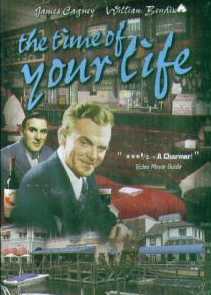
The Time Of Your Life with a Show-Boat

| Around the beginning of 2004, I watched
a long out of print flick recently released on DVD.
"The Time Of Your Life" basically is centered
around a bar, Nick's Pacific Street Saloon and James
Cagney as a very rich guy who likes to help people out.
It is unclear if he is in the mafia or just a
philanthropist, but in the bar there are various
eccentric characters, like an old cowboy, a tap dancer,
and more, including most notably, Willie "The Marble
Game Maniac" as the pinball addict. Near the end of
the flick, Willie beats the pin, flags fly out and
fireworks. The movie was eh, "ok" and I soon
forgot about it. At the beginning of March, 2004, I get a
peculiar email from a Jeanna Crawford-Ellis in Burbank,
California telling me about a pin she and her husband
bought a Chicago Coin pinball machine from around the
1930's, that appeared to have been used in a film, based
on her experience working in the film industry. When she
said the pin had flags coming out the sides and top of
the pin, I thought, "Could it be, eh, no way. That
pin's gotta be long gone." I gave Jeanna noted
pinball historian Russ Jensen's
site address, which has vintage pin info and Russ'
email address and forgot all about the situation.
Speaking of Russ' site, for more info about this movie
and more pin movie info, read Russ' article, "The
Time Of Your Life....And More!" The plot thickens. I got an email from Jeanna thanking me for referring her to Russ, who it turns out, did verify this pin as the one and only pin in this flick, modified from a '41 Chicago Coin Show Boat pin. She even sent me some pics to prove she wasn't kidding. At this point, I almost fell out of my chair. Jeanna told me in her next email that she was with her family at a local restaurant they frequent, stopped into a brand new antique/junk shop across the street after they saw this pin in the window. They didn't know it had a drop down backglass or the flags until they brought it home. The shop owner said he bought the pin from a couple junk dealers who lived in a trailer, who didn't even have a phone. The pin has no power supply, so there's no way to test it at this time. According to Russ Jensen, the two backglasses were reproduced for the game, and replaced the name, etc in the center of the backglasses with different art, and repainted some minor bits of the playfield. This is why the game was difficult to identify. Fast forward to Thursday, April 8, 2004. This pin was auctioned on Ebay by the owner, with a $3,000 reserve. I would have never known about the auction, but Jim Schelberg, editor of The Pingame Journal sent me an email about it on Saturday, April 10th. Bidding was originally set at $400 for the opening bid. Thinking the reserve couldn't be too high, I was kicking around the idea of placing a bid, but when I checked the bidding on Sunday, April 11th, the opening bid was now set at $1,300 with no bidders yet. The auction ended that night with just two bids, the final one at $1,550. According to Russ Jensen, a very excited, Dennis Dodel from St. Louis was the winner, and although the bid didn't meet the reserve, he became the proud owner of this once in a lifetime piece of history. On Thursday, March 6, 2014, approximately ten years after this all began, Dennis let me know that he donated this unique bit of history to The Pacific Pinball Museum, in Alameda, California. Here's the Internet Pinball Database entry on this one of a kind pin, known as "1776." They also have additional pics taken by the owner. Just click on the link. Now, onto the pics I have.....drool:) |
CLICK ON A PIC TO ENLARGE
Russ Jensen actually got to visit the
Ellis family on Saturday, March 6th and saw this pin in
person! He took some pics, seen below, and here's his
notes about this historic visit:
|
CLICK ON ANY PIC TO ENLARGE